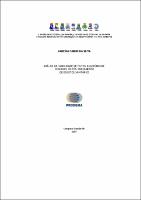| Compartilhamento |


|
Use este identificador para citar ou linkar para este item:
http://tede.bc.uepb.edu.br/jspui/handle/tede/2146Registro completo de metadados
| Campo DC | Valor | Idioma |
|---|---|---|
| dc.creator | Silva, Vanessa Farias da | - |
| dc.creator.Lattes | http://lattes.cnpq.br/0100430493198622 | por |
| dc.contributor.advisor1 | Sousa, José Tavares de | - |
| dc.contributor.advisor1Lattes | http://buscatextual.cnpq.br/buscatextual/visualizacv.do?id=K4783224Z6 | por |
| dc.contributor.referee1 | Vieira, Fernando Fernandes | - |
| dc.contributor.referee1Lattes | http://lattes.cnpq.br/1129711375633007 | por |
| dc.contributor.referee2 | Leite, Valderi Duarte | - |
| dc.contributor.referee2Lattes | http://buscatextual.cnpq.br/buscatextual/visualizacv.do?id=K4787071D5 | por |
| dc.contributor.referee3 | Silva, Afrânio Gabriel da | - |
| dc.contributor.referee3Lattes | http://lattes.cnpq.br/1033587485442143 | por |
| dc.date.accessioned | 2015-09-25T12:23:30Z | - |
| dc.date.available | 2009-09-16 | - |
| dc.date.issued | 2005-12-22 | - |
| dc.identifier.citation | SILVA, Vanessa Farias da. ANÁLISE DA VIABILIDADE DE FILTRO ANAERÓBIO DE CHICANAS NO PÓS-TRATAMENTO DE ESGOTOS SANITÁRIOS. 2005. 143 f. Dissertação (Mestrado em Gerenciamento Ambiental) - Universidade Estadual da Paraíba, Campina Grande, 2005. | por |
| dc.identifier.uri | http://tede.bc.uepb.edu.br/tede/jspui/handle/tede/2146 | - |
| dc.description.resumo | O presente trabalho teve como objetivo avaliar o desempenho de filtro anaeróbio de chicanas (FAC) no pós-tratamento de efluente anaeróbio, usando garrafas PET como material de enchimento. O experimento foi realizado em três fases, delimitado pelos três tempos de detenção hidráulicas, 7, 9 e 10 dias, respectivamente. As análises dos efluentes do reator UASB e do FAC foram realizadas semanalmente, averiguando a remoção de matéria orgânica na forma de DBO5 e DQO, sólidos e suas frações, nutrientes (nitrogênio e fósforo) e indicadores de contaminação fecal (coliformes termotolerantes). Os resultados mostraram que não ocorreram diferenças significativas no efluente do FAC entre as três fases, em relação a matéria orgânica e sólidos (ao nível de 5%), mas houve diferença quanto a condutividade elétrica, nitrogênio e coliformes termotolerantes. O FAC apresentou bom desempenho quanto à remoção de matéria orgânica (65% para DQO e 64% para DBO5 durante a 1ª fase) e sólidos suspensos (81% para SST e 83% para SSV durante a 1ª fase). Diante desses resultados, observa-se que o FAC apresentou boa eficiência no pós-tratamento de efluente anaeróbio resultando em um efluente clarificado com baixas concentrações de matéria orgânica (12mg DBO5.L-1), sólidos suspensos (<10 mg SST. L-1) e turbidez (<10 UNT). Com relação à qualidade sanitária, o efluente produzido apresentava concentrações de coliformes termotolerantes variando de 103 a 104 UFC.100 mL-1, portanto valores acima dos padrões estabelecidos pelo OMS (1989) para ser utilizado em irrigação irrestrita. | por |
| dc.description.abstract | The objective of this thesis is to evaluate the performance of anaerobic filter with baffles (FAC) for the post treatment of anaerobic effluent and using rings cut from PET bottles as filling medium. The experiment was carried out in three phases characterized by the hydraulic retention times of 7, 9 and 10 days, respectively. The analysis of the UASB and FAC effluents was carried out weekly to evaluate the removal efficiency of organic material expressed as BOD5 e COD, solids and its different fractions, nutrients (nitrogen and phosphorus) and indicators of faecal contamination (thermotolerant Coliforms). The results showed that there were no significant differences between the FAC effluent during the three phases with respect to organic material and suspended solids (at 5% significance level), but there were differences in the electric conductivity, nitrogen and thermotolerant Coliforms. The FAC presented good performance of organic material removal (65% for COD and 64% for BOD5 during the first phase) and suspended solids (81% for TSS and 83% for VSS during the first phase). Thus it can be noted that the FAC presented good post treatment efficiency of anaerobic effluents, resulting in clarified effluent with low concentrations of organic material (12mg BOD5.L-1), suspended solids (<10 mg TSS. L-1) and turbidity (<10 UNT). With respect to sanitary quality the produced effluent had concentrations of thermotolerant in the range of 103 to 104 UFC.100 mL-1, hence above the standards established by the WHO (1989) for utilization in irrigation without restrictions. | eng |
| dc.description.provenance | Made available in DSpace on 2015-09-25T12:23:30Z (GMT). No. of bitstreams: 1 VANESSA F SILVA.pdf: 1400231 bytes, checksum: fb9f24d41beb924c130d174f918f19f8 (MD5) Previous issue date: 2005-12-22 | eng |
| dc.format | application/pdf | por |
| dc.thumbnail.url | http://tede.bc.uepb.edu.br/jspui/retrieve/4155/VANESSA%20F%20SILVA.pdf.jpg | * |
| dc.language | por | por |
| dc.publisher | Universidade Estadual da Paraíba | por |
| dc.publisher.department | Gerenciamento Ambiental | por |
| dc.publisher.country | BR | por |
| dc.publisher.initials | UEPB | por |
| dc.publisher.program | Programa de Pós-Graduação em Desenvolvimento e Meio Ambiente - PRODEMA | por |
| dc.rights | Acesso Aberto | por |
| dc.subject | Pós-tratamento | por |
| dc.subject | Filtro de chicanas | por |
| dc.subject | Tratamento anaeróbio | por |
| dc.subject | Post treatment | eng |
| dc.subject | Filter with baffles | eng |
| dc.subject | Anaerobic treatment | eng |
| dc.subject.cnpq | CNPQ::ENGENHARIAS::ENGENHARIA MECANICA::ENGENHARIA TERMICA::CONTROLE AMBIENTAL | por |
| dc.title | ANÁLISE DA VIABILIDADE DE FILTRO ANAERÓBIO DE CHICANAS NO PÓS-TRATAMENTO DE ESGOTOS SANITÁRIOS | por |
| dc.type | Dissertação | por |
| Aparece nas coleções: | PRODEMA - Dissertações | |
Arquivos associados a este item:
| Arquivo | Descrição | Tamanho | Formato | |
|---|---|---|---|---|
| VANESSA F SILVA.pdf | 1.37 MB | Adobe PDF |  Baixar/Abrir Pré-Visualizar |
Os itens no repositório estão protegidos por copyright, com todos os direitos reservados, salvo quando é indicado o contrário.




